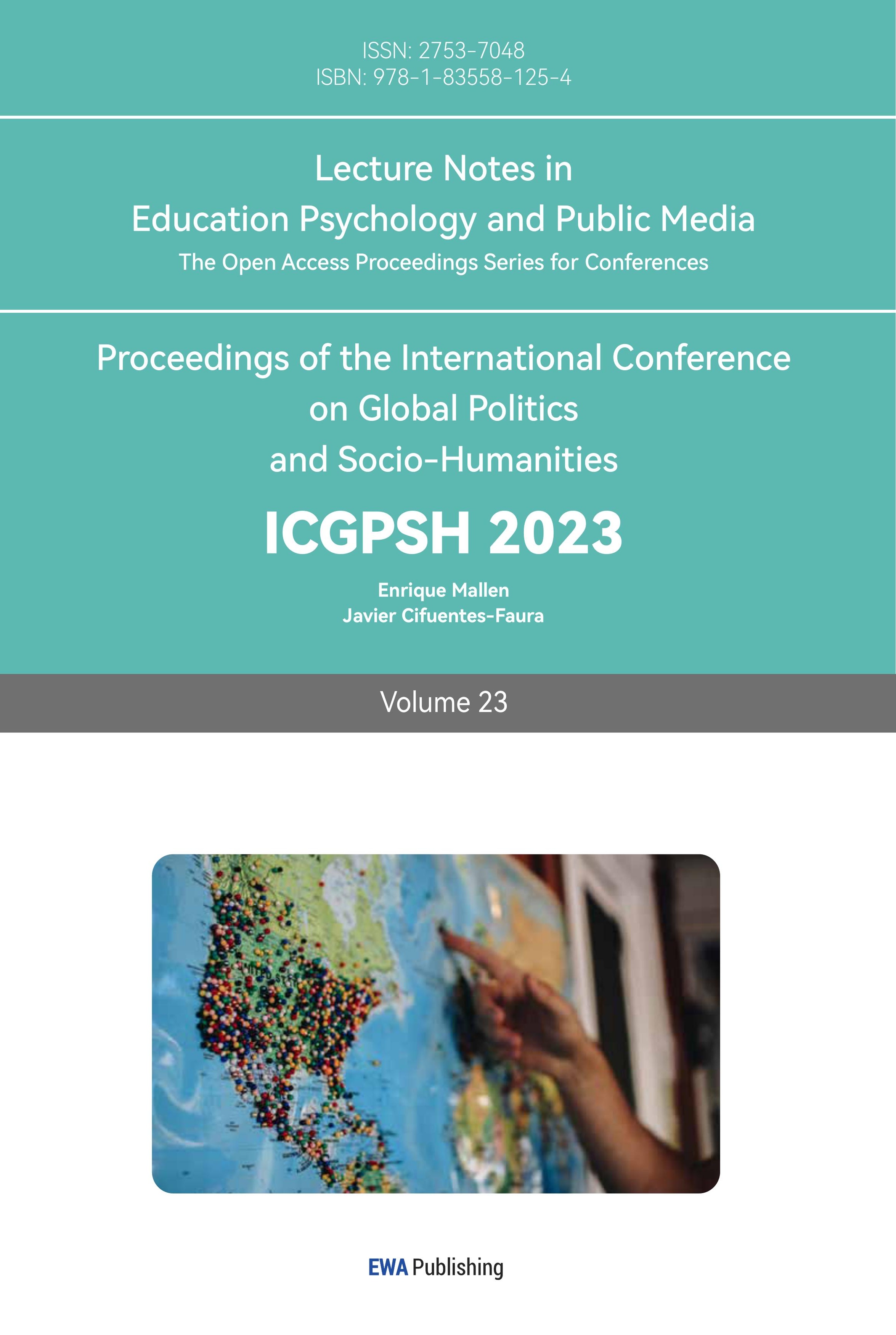References
[1]. King, C. A., & Merchant, C. R. J. A. o. S. R. (2008). Social and Interpersonal Factors Relating to Adolescent Suicidality: A Review of the Literature. 12, 181 - 196.
[2]. Whitlock, J., Wyman, P. A., & Moore, S. R. (2014). Connectedness and suicide prevention in adolescents: pathways and implications. Suicide Life Threat Behav, 44(3), 246-272. doi:10.1111/sltb.12071.
[3]. Ozawa, S., Nakatani, H., Miyauchi, C. M., Hiraki, K., & Okanoya, K. (2022). Synergistic effects of disgust and anger on amygdala activation while recalling memories of interpersonal stress: An fMRI study. Int J Psychophysiol, 182, 39-46. doi:10.1016/j.ijpsycho.2022.09.008.
[4]. Buitron, V., Hill, R. M., Pettit, J. W., Green, K. L., Hatkevich, C., & Sharp, C. J. J. o. a. d. (2016). Interpersonal stress and suicidal ideation in adolescence: An indirect association through perceived burdensomeness toward others. 190, 143-149.
[5]. Hammen, C. (2003). Interpersonal stress and depression in women. J Affect Disord, 74(1), 49-57. doi:10.1016/s0165-0327(02)00430-5.
[6]. Johnson, J. G., Cohen, P., Gould, M. S., Kasen, S., Brown, J., & Brook, J. S. (2002). Childhood adversities, interpersonal difficulties, and risk for suicide attempts during late adolescence and early adulthood. Arch Gen Psychiatry, 59(8), 741-749. doi:10.1001/archpsyc.59.8.741.
[7]. Kavanagh, D. J. (1986). Stress, Appraisal and CopingS. Lazarus and S. Folkman, New York: Springer, 1984, pp. 444, $31.95. Behavioural and Cognitive Psychotherapy, 14(4), 345-345. doi:10.1017/S0141347300015019.
[8]. Liu, Shanshan, Zhang, Qingqing, Liu, Xinying, He, Rui, & Zhu, Chunyan. 2011 A new species of the genus Pterostilbene (Coleoptera, Staphylinidae, Pterostilbene) from China. (2023). Meta-analysis of the correlation between interpersonal stress and suicidal ideation Chinese Journal of Evidence-Based Medicine. 23(04), 410-415.
[9]. Sheets, E. S., & Craighead, W. E. (2014). Comparing chronic interpersonal and noninterpersonal stress domains as predictors of depression recurrence in emerging adults. Behaviour Research and Therapy, 63, 36-42. doi:https://doi.org/10.1016/j.brat.2014.09.001.
[10]. Umberson, D., Crosnoe, R., & Reczek, C. (2010). Social Relationships and Health Behavior Across Life Course. Annu Rev Sociol, 36, 139-157. doi:10.1146/annurev-soc-070308-120011.
[11]. Bolger, N., DeLongis, A., Kessler, R. C., & Schilling, E. A. (1989). Effects of daily stress on negative mood. J Pers Soc Psychol, 57(5), 808-818. doi:10.1037//0022-3514.57.5.808.
Cite this article
Sun,M. (2023). Mechanisms and Effects of Interpersonal Pressure. Lecture Notes in Education Psychology and Public Media,23,62-66.
Data availability
The datasets used and/or analyzed during the current study will be available from the authors upon reasonable request.
Disclaimer/Publisher's Note
The statements, opinions and data contained in all publications are solely those of the individual author(s) and contributor(s) and not of EWA Publishing and/or the editor(s). EWA Publishing and/or the editor(s) disclaim responsibility for any injury to people or property resulting from any ideas, methods, instructions or products referred to in the content.
About volume
Volume title: Proceedings of the International Conference on Global Politics and Socio-Humanities
© 2024 by the author(s). Licensee EWA Publishing, Oxford, UK. This article is an open access article distributed under the terms and
conditions of the Creative Commons Attribution (CC BY) license. Authors who
publish this series agree to the following terms:
1. Authors retain copyright and grant the series right of first publication with the work simultaneously licensed under a Creative Commons
Attribution License that allows others to share the work with an acknowledgment of the work's authorship and initial publication in this
series.
2. Authors are able to enter into separate, additional contractual arrangements for the non-exclusive distribution of the series's published
version of the work (e.g., post it to an institutional repository or publish it in a book), with an acknowledgment of its initial
publication in this series.
3. Authors are permitted and encouraged to post their work online (e.g., in institutional repositories or on their website) prior to and
during the submission process, as it can lead to productive exchanges, as well as earlier and greater citation of published work (See
Open access policy for details).
References
[1]. King, C. A., & Merchant, C. R. J. A. o. S. R. (2008). Social and Interpersonal Factors Relating to Adolescent Suicidality: A Review of the Literature. 12, 181 - 196.
[2]. Whitlock, J., Wyman, P. A., & Moore, S. R. (2014). Connectedness and suicide prevention in adolescents: pathways and implications. Suicide Life Threat Behav, 44(3), 246-272. doi:10.1111/sltb.12071.
[3]. Ozawa, S., Nakatani, H., Miyauchi, C. M., Hiraki, K., & Okanoya, K. (2022). Synergistic effects of disgust and anger on amygdala activation while recalling memories of interpersonal stress: An fMRI study. Int J Psychophysiol, 182, 39-46. doi:10.1016/j.ijpsycho.2022.09.008.
[4]. Buitron, V., Hill, R. M., Pettit, J. W., Green, K. L., Hatkevich, C., & Sharp, C. J. J. o. a. d. (2016). Interpersonal stress and suicidal ideation in adolescence: An indirect association through perceived burdensomeness toward others. 190, 143-149.
[5]. Hammen, C. (2003). Interpersonal stress and depression in women. J Affect Disord, 74(1), 49-57. doi:10.1016/s0165-0327(02)00430-5.
[6]. Johnson, J. G., Cohen, P., Gould, M. S., Kasen, S., Brown, J., & Brook, J. S. (2002). Childhood adversities, interpersonal difficulties, and risk for suicide attempts during late adolescence and early adulthood. Arch Gen Psychiatry, 59(8), 741-749. doi:10.1001/archpsyc.59.8.741.
[7]. Kavanagh, D. J. (1986). Stress, Appraisal and CopingS. Lazarus and S. Folkman, New York: Springer, 1984, pp. 444, $31.95. Behavioural and Cognitive Psychotherapy, 14(4), 345-345. doi:10.1017/S0141347300015019.
[8]. Liu, Shanshan, Zhang, Qingqing, Liu, Xinying, He, Rui, & Zhu, Chunyan. 2011 A new species of the genus Pterostilbene (Coleoptera, Staphylinidae, Pterostilbene) from China. (2023). Meta-analysis of the correlation between interpersonal stress and suicidal ideation Chinese Journal of Evidence-Based Medicine. 23(04), 410-415.
[9]. Sheets, E. S., & Craighead, W. E. (2014). Comparing chronic interpersonal and noninterpersonal stress domains as predictors of depression recurrence in emerging adults. Behaviour Research and Therapy, 63, 36-42. doi:https://doi.org/10.1016/j.brat.2014.09.001.
[10]. Umberson, D., Crosnoe, R., & Reczek, C. (2010). Social Relationships and Health Behavior Across Life Course. Annu Rev Sociol, 36, 139-157. doi:10.1146/annurev-soc-070308-120011.
[11]. Bolger, N., DeLongis, A., Kessler, R. C., & Schilling, E. A. (1989). Effects of daily stress on negative mood. J Pers Soc Psychol, 57(5), 808-818. doi:10.1037//0022-3514.57.5.808.









